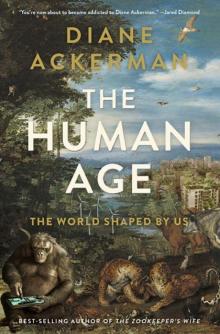- Home
- Diane Ackerman
The Rarest of the Rare Page 8
The Rarest of the Rare Read online
Page 8
With a buoyancy I quickly come to prize, Hiroshi lifts his glass of beer and stalwartly offers the expedition toast: “Ahodori! Kampai!”
After dinner, we carry our suitcases through the winding streets toward the Toho University campus. In the shadow of a building, a drunken huddle of college students sway with their arms around one another’s shoulders, singing songs into the night. Penguins in the Antarctic huddle this way to keep warm (the French say they are “making a turtle”), and it is the same with chummy fraternity boys the world over. The sight reminds me that we are actually in Tokyo’s version of Collegetown. Soon the sumo restaurant’s owner catches up with us on her bicycle—we have left behind a birding pamphlet by accident; she thought we might need it. Many bowed heads and renewed thanks. Catty-corner from the campus, we pause at a restaurant, where Hiroshi talks with the owner.
“Tomorrow morning, she will open at eight and give you breakfast,” he tells us. “She will expect you.”
Then we cross the road, Hiroshi checks us in with the campus guards at the main gate, and we walk past a small flower garden to a building that has university guestrooms on the third floor. At the end of the hall, we find a toilet, a refrigerator, a deep Japanese bathtub, and vending machines offering toothpaste and shaving supplies. We have traveled thirty hours and crossed the dateline, but we are too giddy and excited to sleep. There is still time to watch historic films of Torishima, from Hiroshi’s library of albatross books, films, and records (many folksingers and rock groups have sung about albatrosses). So Hiroshi guides us to his office in a nearby building. Venus shines low and bright overhead, like a searchlight that has caught us in its beam. We seem to have fallen through a crack in our culture into a world in which everything is strange and new, and we don’t know what sight to expect beyond the next lamppost.
As we climb the stairs to Hiroshi’s office, we see photographs of albatrosses on the walls. A light at the end of the corridor welcomes us into a room overflowing with books, wildlife posters, and more photographs of albatrosses, including a large banner on which an almost life-sized adult albatross angles across the sky with wings spread, and Hiroshi’s pièce de résistance, a framed close-up of a fluffy, potbellied, short-tailed albatross chick. We sit down on benches around a wooden table. Three graduate stu dents arrive; one brings out a bottle of white wine, another cuts up some fruit, and we all sit down to watch films of albatrosses. The first is an old black-and-white film showing the large flocks of birds that once blanketed the island and pleated the cliffs with white. Japanese observers said that bird-encrusted Torishima looked like an ice volcano, bubbling white. So many albatrosses filled the skies that a constant snowstorm seemed to be traveling around the island. Offshore, the waves appeared permanently white-capped, so large and dense were the rafts of these magnificent birds. Next, in sharp contrast, a more recent color film shows us the few birds that are left, and we shake our heads in disbelief. How could this have happened so fast? The film includes a brief glimpse of the short-tail’s extravagant courtship dance. When he sees it, Peter explodes with excitement and bends forward for a closer look.
“They stand on their toes! Oh, and look at that—scapular touch, head wagging, castanets!” He lifts his tightly clenched fists in the air and shakes the electricity from them.
Mutually besotted, a courting pair throw their heads skyward again, flap their huge wings, and begin clacking their bills like flamenco dancers gone berserk—castanets. My heart starts to pound. Even on film they are breathtakingly beautiful, with their egg-yolk-yellow crowns. Their quivering bills are pink, with what looks like blue lipstick drawn right at the tip and inside the mouth, and a thin black stripe outlines the base of the bill. Otherwise, the older birds are mainly white. But some immature birds are chocolate-brown, daubed with white epaulets. Leaning forward on the table, crippled by fatigue, we stare in amazement at the small screen, which cannot contain so large a bird, at the two-dimensional sizzle of electrons, which cannot depict the drama that awaits us, and we are saturated with excitement. When the films end, we make our final travel plans with Hiroshi, toast the albatrosses one last time with an uplifted glass and an “Ahodori! Kampai!,” and return to our rooms to sleep.
Early the next morning, two graduate students find us having Japanese breakfast at the local restaurant, where, to our delight, we see Hiroshi’s photographs of a short-tailed albatross chick hanging on the wall like the familiar portrait of a royal heir. They hurry us downstairs, where Hiroshi is waiting with our luggage. He motions to his watch; there are many miles to cover today, and we must hurry.
With our large knapsacks we look like turtles of an exotic species, carrying our homes with us, but such carapaces make it easy for us to spot one another among the city’s tight crowds. One bus, two trains, one monorail, and one airplane ride later we land on Hachijojima, a small volcanic island below the seven islands of Izu, which dot the ocean south of Tokyo like the pearls in a necklace whose clasp has broken. Hachijojima’s ten thousand inhabitants are mainly fishermen and their families. Sometimes people fly down from Tokyo to go game fishing, or to take a rest cure at the hot springs. There are no Westerners. The trees chime with flocks of singing bulbuls, clouds surge at night and snag on the peaks of the volcano, and the ocean blows up a fine mist at dawn. Because Hachijojima has the last airport in the islands, travelers heading for even more remote locales begin their far-flung travels from its docks. There is always a place such as this, a crossroads between the familiar and the unknown, a caravanserai in the desert, a Marrakech. In the United States in the nineteenth century it was Mark Twain’s St. Louis, where people stopped to outfit themselves before crossing the Mississippi and entering the wild and unruly lands to the west. “Outlanders” such farouche travelers were called, and their ways were dubbed “outlandish.” Hachijojima is a smaller crossroads and lacks the con men, hucksters, and desperadoes. It is a last handhold before one wades out into the plunging Pacific. It is a place for the quiet severing of ties to anything like culture. Culture is what people invent when they have lost nature. And there is nothing more certain or powerful on Hachijojima than the wrath of the wind and water, whose compound decree must be deciphered every day from wisdom and weather maps.
On Hachijojima, we stay at a small guesthouse owned by a couple who have become Hiroshi’s friends over the years—Eke-san and Toma-san—who meet us at the airport with their van. Toma-san owns a fishing boat and guides game fishermen around the island on sporting Odysseys, and he also owns woodlands on the island. Hibiscus and bird-of-paradise spill from the roadway as we drive into a nearby fishing village and up a narrow alleyway to their house near the docks. Leaving our shoes at the door, we abandon the dirt of the outside world and slip into waiting sandals. Even the dust of the world is rich and beautiful in Japanese life, but it belongs outside.
“Dozo,” Eke-san says, motioning to a low table in a room dominated by two such tables and a TV set in one corner. We sit down on the floor beside a table, slip our feet under the black-and-white quilted skirt hanging from it, and discover a hivelike warmth underneath. An electric heater attached to the underside of the table showers everyone’s legs with a toasty glow. This main room is rectangular and has sliding doors at either side—one set leading into the hallway, the other into the kitchen and backyard. A fitted pink rug runs the length of the floor; there are also two small throw rugs—one with owls, which you step on when you come in from the hallway, one with ducks, where you enter from the kitchen. A cabinet at the far end of the room holds a framed copy of Hiroshi’s photograph of the short-tailed albatross chick, which we are starting to regard as our own cabalistic sign. Next to it stands a brass clock, held aloft by two flying cranes (the Japanese symbol of longevity). A wooden plaque with the family’s emblem, a sword and a flower, leans on the other side of the cabinet. Ten calligraphy panels stretch above the doors to the hallway.
Eke-san sits down on her knees beside us, bows with her hands on her thighs. A w
oman of fifty-seven with short, swept-back, dark hair, she smiles modestly and graciously and offers us coffee. Hiroshi turns on the TV to check the local weather, and we scrutinize the weather maps. A northwest wind and a typhoon are heading west through the region. We look carefully at the isobars and discuss the approaching systems. A tight swirl of lines, lying close together and changing direction, signals a typhoon. To seafarers, the pattern is clear as a fingerprint. Three typhoons have passed close to Torishima this year, washing away the soil. As Hiroshi counts the systems, he tucks his fingers in one by one; Peter counts them, too, but bends his fingers outward. We may be spared, but the weather is always dicey in this season, so we decide to wait for the next report.
Soon lunch is served, and lacquered boxes appear with edible mysteries inside. Many new vegetables and fruits and seafood are set in front of us, nameless and piquant, which we eat with a mixture of hunger and curiosity. A large electric hamper of rice stands beside a thermos of hot water near the table. Eke-san smiles at our huge appetites. Birds put on a lot of weight before migration. Some leaf or wood warblers increase their weight by half to make the journey to or from South America. People often do something similar before setting out on an expedition. You don’t know when you’ll find your next meal.
Bowing our heads slightly, we thank Eke-san in Japanese, saying, “Oishii” (“It tastes good”). Soon we will pay a call on the sencho (captain) whose small fishing boat will carry us to Torishima, and we need to buy our provisions. But first we must visit the local government office. Hiroshi returned from his last trip to Torishima with photographs of terrible erosion, and he has persuaded the environmental agency of Japan to send out botanists and soil-management people to see if anything can be done about it.
At an office building in town, a tall man whose name translates as Star Field greets us, and Hiroshi shows him photographs of the Torishima grass, and of the recent erosion in areas his people will be called upon to replant next year. All this commotion must be strange for this local government office. Hachijojima is a small island; Torishima is minute and so out of the way, not just off the beaten track but eruptive, wild, and off-limits. Now, suddenly, the world is coming to Torishima, with video cameras and scientists, as an object lesson in how to pull a species back from the brink of extinction. Hiroshi hopes these botanists and soil specialists will be able to halt the erosion, which is obliterating precious nesting sites. A lot of the island’s vegetation has been buried by lava, and in those areas vegetation struggles to insinuate its roots through fresh ash.
A secretary serves us green tea in blue-and-white cups decorated with fans. Light and spinachy, the green tea revives us. Hiroshi hangs his brown corduroy cap from his knee. Two large white scars stretch across the top of his left hand—the stigmata of his trade. He received these gashes handling albatross chicks, whose sharp bills are designed to nab a squid in one blow; by comparison, a hand makes a slow target.
Looking at a photograph of a barren hillside, I see where ash has been blown as if by a dust storm. Plant roots need a mat system so they can bind the loose ash together. And albatrosses need vegetation to build their nests. They dig a shallow scrape in the ground and pull sand and grass together. It’s not enough to give a bird an island; you have to give it the right vegetation, too, so that it can cradle its egg. A couple of years ago, as an experiment, Hiroshi planted eulalia on a small area of the island. There was an immediate increase in the number of albatrosses that were hatched. Now he urgently hopes to replace the rest of the island’s lost vegetation. He will be asking the botanists to plant in June, the rainy season, with a view to having the nesting area ready for the birds next October.
Ten of these men will be meeting us on the island, and so they discuss supplies and equipment with Hiroshi. When we take our leave of them, we go to a bakery, a grocery store, and a drinks store. If we get weathered in on Torishima, we’ll be glad of the extra provisions. Throughout the town we find flagstone sidewalks made of lava honeycombed with air pockets, which is soft and easy to cut. Such beautiful sidewalks are not there for tourists, who come infrequently to Hachijojima. Every day is a special occasion, they seem to say; what touches one’s daily life should please the senses. Yellow chrysanthemums, white star flowers, and bromeliads cascade from the steep rock walls that line the winding streets. Some walls are studded with large, sharp stones, hurled by the volcano, which sank into the ash. Standing outside one of the shops, we watch the fishing boats along the wharf as Hiroshi runs down his list. Slightly bowlegged, Hiroshi wears a blue bandanna tucked into the back pocket of his jeans, a blue-and-black-checked shirt, and his brown corduroy cap from the U.S. Fish and Wildlife Service, which he got on a recent trip to Alaska. All the supplies have been purchased. He sighs easily at last. A cormorant perches on a wooden stanchion and we lift our binoculars to our eyes as it arches its wings into a Prussian cross. In China, a fisherman will put a tight ring around the neck of a leashed cormorant (so that it can’t swallow what it catches) and have it fish for him from his junk. Unlike other fishing birds, it is not waterproof; otherwise it would not be able to dive so well. Here, in freedom, the bird spreads its wings to dry them in the sun.
“Our first trip to Torishima—very soon now,” Peter says, anticipation bubbling across his suntanned face.
“I have been there thirty-seven times,” Hiroshi says, “and I am still as excited as you are.”
“You’ve been there more than anyone else on earth, anyone in history,” Peter says, letting his binoculars drop to his chest. “And you’ve been such a good protector of the birds. When you arrive, the albatrosses should line up, rock forward on their feet, and bow.” He rocks onto his toes, angles his arms out to his side, and does a stooping half-bow. Hiroshi picks up another part of the courting dance and arches his chest out and arms back. I add yet another gesture by kissing my left shoulder, then my right, with bent arms out to my sides. I do not know what passersby make of this scene, but fishermen on small volcanic islands in the South Pacific are surely used to all manner of strange birds. And the castaneting and whinnying we three do next probably doesn’t surprise them much either.
Walking down along the wharf to the fish-packing stalls, we watch the boats unload their catch. In the failing light, only the boat decks shine brightly as men in blue suits and white terrycloth headbands sort mackerel, tuna, and jumbo sardines, tossing them like bars of pure silver into waiting baskets. Hiroshi knows most of these men by sight and salutation. A friend of his lifts a large rainbow by its gills and holds it up with the Would-you-look-at-the-size-of-this-honey expression shared by fishermen the world over; Hiroshi grins appreciatively. Setting the rainbow in a basket, the man gives Hiroshi three large sardines to take home to Eke-san. Oily fish such as these are eaten locally because they deteriorate quickly. The other, white-fleshed fish will be packed in ice and shipped to Tokyo. Thanking the fisherman and wishing him a good season, we head back up the hill, since it’s nearly time for dinner.
At home, we find Eke-san arranging flowers. In one room, there is a small display of wildflowers—purple thistles, bittersweet, grasses, and leaves in a black lacquer dish; the water in the dish is as important as the leaves lying in it or the space between the branches or the sky hanging above. There is something robustly damp and feminine about the arrangement, which folds into itself over and over. In another room, a decidedly masculine arrangement of bamboo and bird-of-paradise juts skyward. We sit down to eat, tucking our legs under the quilt, warming them at the heater. Eke-san’s twenty-one-year-old daughter brings us hot green tea. Tonight there is a fried fish Westerners call leatherjacket (the Japanese, who find such a name unpalatable, call it “leather remove”), along with sushi, tofu, and vegetables, and mandarin oranges for dessert. Conversations in Japanese and English and pantomime brighten the room. But when the weather report comes on TV, talk stops. In a kingdom of fishermen, the weather is emperor. The only other event that halts conversation is sumo wrestling. This is t
he week of the sumo championships, and we watch the “Hawaiian Volcano,” a rippling mass of human lava weighing five hundred pounds and wearing only a thick jockstrap fringed with what look like drape pulls, ooze across the stage.
“Ah, but he has weak ankles,” Hiroshi says knowingly. “In this sport, size doesn’t always matter. And unlike American wrestling, there aren’t weight categories. Big men can wrestle smaller men, and sometimes the smaller man wins because he’s faster.” He explains that the strategy lies in knowing your talents, your opponent’s weaknesses, and what techniques will bridge the two. Somehow it seems perfectly natural that Hiroshi, a man of zest and good humor who appreciates all the forces of Nature, should be passionate about lighter-than-air albatrosses, so gentle and leaflike, as well as about the many-hammed sumo wrestlers.
With elaborate ceremony, and a stylized referee in ancient costume, the combat begins, and ends a few seconds later when the Hawaiian Volcano stumbles on his weak ankles and his haunches rumble to the ground. This has been so thrilling that Toma-san leaps to his feet and, beside himself with excitement, lifts a glass of strong Japanese spirits to the victor: “Kampai!” he says, fist rolled tight and held aloft.
Jet lag, time lag, and fatigue seem not so much to catch up with us as to collide in our brains, and by nine we are yawning. After thanking our hosts, we climb the stairs and wash at a long communal sink in the hallway. Eke-san arrives a moment later and leads Peter to his room, sliding the main door open, and arranging a mattress on the floor.

 A Natural History of Love
A Natural History of Love The Rarest of the Rare: Vanishing Animals, Timeless Worlds
The Rarest of the Rare: Vanishing Animals, Timeless Worlds The Zookeeper's Wife: A War Story
The Zookeeper's Wife: A War Story The Human Age: The World Shaped by Us
The Human Age: The World Shaped by Us A Natural History of the Senses
A Natural History of the Senses One Hundred Names for Love: A Memoir
One Hundred Names for Love: A Memoir The Rarest of the Rare
The Rarest of the Rare